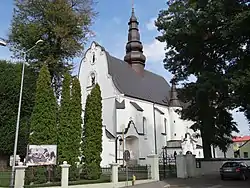Kańczuga
Kańczuga (Polish: [kaj̃ˈt͡ʂuɡa]; Ukrainian: Каньчу́га, romanized: Kanʹchúha) is a town in Przeworsk County, Subcarpathian Voivodeship, Poland, with a population of 3,187 inhabitants on 2 June 2009.[1] The town was an early centre of the Polish automobile industry. Buses based on Fiat 621R and used in Kraków had bodywork fitted in Kańczuga. Today, the town is known for the restoration of old SAABs.[2]
Kańczuga | |
|---|---|
 Archangel Michael Church | |
 Coat of arms | |
 Kańczuga  Kańczuga | |
| Coordinates: 50°0′N 22°24′E | |
| Country | |
| Voivodeship | |
| County | Przeworsk |
| Gmina | Kańczuga |
| Government | |
| • Mayor | Andrzej Żygadło |
| Area | |
| • Total | 7.61 km2 (2.94 sq mi) |
| Elevation | 220 m (720 ft) |
| Population (2006) | |
| • Total | 3,211 |
| • Density | 420/km2 (1,100/sq mi) |
| Time zone | UTC+1 (CET) |
| • Summer (DST) | UTC+2 (CEST) |
| Postal code | 37-220 |
| Car plates | RPZ |
| Website | http://www.kanczuga.pl |
History
Kańczuga was first mentioned in documents from 1340, when it was part of Red Ruthenia. At that time, the village belonged to the noble Pilecki family. In the second half of the 14th century, Elżbieta Pilecka, the daughter of Kańczuga's founder Otton of Pilcza, married a nobleman from Greater Poland, Wincenty Granowski, and after his death, she married King Wladyslaw Jagiello.
In 1440, Kańczuga received town charter. It still remained in the hands of the Pilecki family, but in the subsequent centuries, Kańczuga was property of such families, as Odrowaz, Kostka, Ostrogski, Lubomirski and Sanguszko. The town, with its deep tunnels used as merchant goods storages, prospered until the late 15th century, when its population reached 3000. In 1498, Kańczuga was burned to the ground in a Wallachian raid, which ended the period of prosperity. In the 16th and early 17th centuries, the area of Kańczuga was frequently raided by the Crimean Tatars. In a 1624 raid, all local villages were burned, and thousands of residents kidnapped.

As a result of the first of Partitions of Poland (Treaty of St-Petersburg dated 5 July 1772), Kańczuga was attributed to the Habsburg Monarchy as part of Austrian Galicia, in which it remained until 1918.[3] When a post office was opened in 1870, the town was in the Przeworsk Bezirkshauptmannschaft.
Before the Holocaust the Kańczuga population was 3000 with at least 40% being Jews. [4]
In August 1942, the Jews living in the town were murdered by the Nazis and their bodies were dumped in a mass grave. Local Poles celebrated by holding a picnic and cheering as their neighbors were killed. Jewish civilians were first rounded up into the synagogue where they were forced to spend several days without food, water, or bathrooms. They were then taken out of the synagogue where the men were made to dig large holes which were used as their communal graves. After the holes were dug, the men, women, and children were shot, with their bodies being tossed into these mass, communal graves.
In April 1945, a pogrom took place in Kánczuga that targeted the few returning Holocaust survivors who gathered for a Passover Seder. During the Seder they were shot by their Polish neighbors.[5]
For more details, see the article Kingdom of Galicia and Lodomeria.
References
- "Population. Size and structure by territorial division" (PDF). 2 June 2009. Archived from the original (PDF) on 26 September 2011. Retrieved 22 June 2009.
- "SAAB's in Kańczuga". Automobilista (81). December 2006. Archived from the original on 28 September 2007.
- Atlas des peuples d'Europe centrale, André et Jean Sellier, 1991, p.88
- https://m.jpost.com/opinion/article-715553
- https://www.jpost.com/diaspora/revisited-the-galician-town-of-kanczuga-in-poland-629454
External links
- Official town webpage
- Witryna o mieście i gminie Kańczuga
- Kanczuga.org - Virtually re-building Jewish Kańczuga